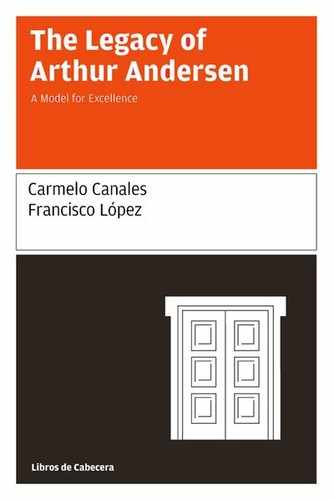5. The Importance of Where and When
Successful business models are the result of complex processes with a touch of alchemy.
It is not only a matter of putting together all the right elements needed to produce the expected reaction, but the right circumstances have to exist in that particular environment. In other words, it is not enough to get the how-things-are-done right, also the where and when things are done count.
Where and how a successful business model is achieved is not always for the businessman to decide. Often, circumstances help. However, the businessman can also have an influence in the result as long as he knows how to adapt the model to the circumstances he faces.
Arthur Andersen development in the USA during the 50s and 60s, two decades of outstanding growth, with the arrival of computers and with the cold war, years in which the USA built a commanding economical and business world leadership, kept until the present days.
On the side, circumstances around the Andersen Model development were different in Spain of those in other countries and could be considered as especially favorable in the social and economic environment of Spain during the 70s and 80s of the last century.
The USA in the 50s and 60s
The world suffered a great commotion during the 40s: the Second World War. The aftermath was a time of reconstruction that brought opportunities and saw the raise of values that were the seeding field for many enterprises.
During the 50s the USA kept engaged in the Korean War. And the Cold War began posing a challenge, a race, with the Soviet Union, that the competitive American people accepted with glee, dedicating a whole generation to the task.
In the 50s and 60s the circumstances were thus right for the development of a model such as the Arthur Andersen one:
- Extolment of effort and work
- Focus on productivity, entailing systematic development of process improvement in industry
- Improvement of administration control systems
- Financial markets growth
- Commercial aviation’s boom
- Progressive growth of international commerce
- Multinational companies emergence
- Birth of computers as business management tools
Under these circumstances, Andersen grew and matured with strength. The same way great American companies did.
The environment favored the Andersen Culture. These years made their mark in that Culture’s main traits and gave form to the model, as we will see later on.
The world in the 70-80s
In the 70-80s the world kept growing strongly and new factors appeared, helping Andersen‘s growth:
- Development of corporate finance, with the mergers and acquisitions boom. The “financial sharks” years
- Process re-engineering becomes fashion
- Mobile phones appear
- Data processing converts to PC and expands
- Society goes into new money cult heights
- Information and communication technologies (ICT) break into all processes, improving productivity spectacularly (Moore’s Law prognosis of computers doubling their capacity every 3 years and reducing their cost by half)
- Consulting in general, and especially information systems and ICT consulting, enjoyed a period of exponential growth that finished only after 2000
Andersen kept growing under these factors and expanding strongly around the world. One of the places reached in those years was Spain.
The Spain of the 70-80s
Modernity came late to Spain, after a Civil War in the 30s and a backward aftermath of hunger and misery in the 40s and 50s. At the end of these two decades the Spanish economy began to open up again and it was in the 70s that this opening-up was a reality, bringing with it the desired fruits. At the beginning of the 70s the country was eager to recover the time lost (40 years), more than a generation.
In the two decades of 70s and 80s, Spain enjoyed:
- A new democracy
- Well prepared universities
- A young disciplined generation ready for pain and effort
- Many state-owned companies with the wish to set in place modern management procedures, as a prelude to a forecast future privatization.
- Need for more transparency and a push for integrity that went from the institutional to the business communities.
- A new tax system implementation
- Tourists coming in, and the wish to know the rest of the world after decades of isolation
- General sympathy for North America
- Respect, even admiration, for things from abroad
- The unstoppable arrival of multinationals
- A social ethic of work and effort
- The opening-up of markets
- Domestic companies going abroad, some for the first time ever
- A certain cult of money, prevailing anywhere, but not so prevalent in Spain, at least between university students.
- A certain innocence, supported by an all but utopian view of the world, coming from the socialism that prevailed in the country political scenery, that set an example in channeling the transition to democracy and marked a great domestic and international success, embodied by King Juan Carlos and Felipe González, who reached global preeminence.
No doubt that this environment facilitated the implementation of the Andersen Model, imported from protestant and rationalistic America, with its demand of dedication, sacrifice and discipline. Nevertheless merit should not be denied because that society contained also a tendency for rule-by-assembly and a tide against capitalist values, and these were successfully avoided or set aside.
